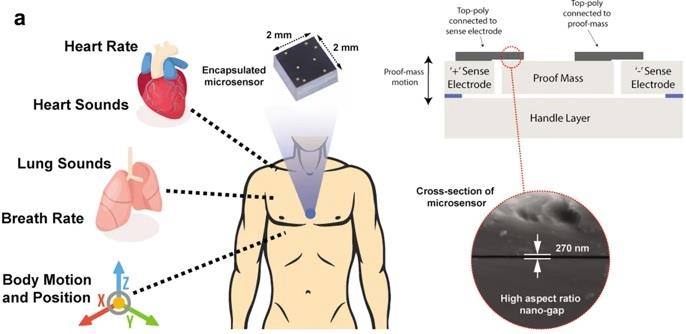
A wearable, hermetically sealed high-precision vibration sensor enables simultaneous monitoring of multiple health factors associated with the cardiopulmonary system, including heart and respiratory rates, heart sounds, lung sounds, and body motion and position of an individual, a study shows.
The sensor combines the characteristics of an accelerometer and a contact microphone to obtain wideband mechano-acoustic physiological signals, which contain valuable information about the cardiopulmonary system.
“Early detection of pathological signatures in mechano-acoustic signals is critical to potentially delay the progression of cardiopulmonary diseases and improve the quality of care,” the researchers say. “Our wearable vibration sensor detects abnormal sounds and symptoms of cardiopulmonary diseases in early stages and provides a unique solution for disease screening and longitudinal monitoring.”
Nano-gap transducers were used in the encapsulated accelerometer contact microphone (ACM) to achieve excellent sensitivity in a wide bandwidth (DC-12 kHz) with high dynamic range. [npj Digit Med 2020;doi:10.1038/s41746-020-0225-7]
The sensors were utilized to acquire health factors of six control participants with varying body mass index. In addition, their feasibility in detecting weak mechano-acoustic signals, such as pathological heart sound and shallow breathing patterns, was assessed in patients with pre-existing conditions.
“Proof-of-concept studies were conducted on healthy control [participants and] patients with pre-existing conditions to monitor physiological and pathological mechano-acoustic signals emanating from the heart and lungs,” the researchers say. “This opens the possibility of identification, early detection and long-term monitoring of cardiopulmonary dysfunctions.”
The sensor responds to a wideband of vibrational frequencies and demonstrates a high dynamic range, enabling it to detect micromovements with high precision along with the macro body motion of the individual. This allows the addition of another layer of information for “correlation of auscultation to daily activities.”
Being a contact microphone, the sensor “only responds to vibrations from its contact surface while being sensitive to airborne acoustic emissions, making it suitable for use in wearable applications,” the researchers say.
However, frequency ranges often overlap for certain applications like seismocardiogram (SCG) and body motion, which is why advanced signal processing techniques are necessary to separate the signals. An effective technique is the recording of signals for a long duration of time and the use of ensemble averaging methods to enhance the signal-to-noise ratio, according to the researchers.
On the other hand, multiple ACM sensors can be used at once to record signals. Processing techniques, which include decomposition, independent component analysis and modulation filtering, can also be applied to reduce motion artifacts. [IEEE Trans Biomed Eng 2017;64:1277-1286; IEEE Eng Med Biol Soc 2006;doi:10.1109/IEMBS.2005.1617037; IEEE Eng Med Biol Soc 2008;doi:10.1109/IEMBS.2008.4649547]
“These features of sensing the SCG, cardiopulmonary sounds, breathing pattern and body motion, in conjunction with computed health parameters of heart rate variability and inter-beat intervals, offer exclusive benefits of multidimensional health monitoring that are currently unavailable,” the researchers claim.